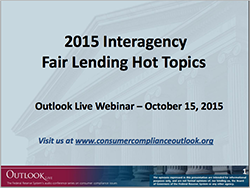The Federal Reserve, CFPB, NCUA, FDIC, OCC, HUD, and DOJ presented their Fair Lending priorities in the recent 2015 Interagency Fair Lending Hot Topics webinar. These topics included: Redlining, Fair Lending Compliance Management Systems, Pricing Reviews, Post Origination Fair Lending Risks, Maternity Leave and Auto Lending. Below we share some of our observations from the call.
Of all the Fair Lending compliance hot topics, there are two that appear to have garnered the most attention over the past 12 months:
- Redlining Risk
- Pricing Risk
Below, we will highlight a few of the regulators' perspectives from the recent call.
Redlining Risk & Components of a Strong Fair Lending Compliance Management System
Redlining was defined as “providing unequal access to credit, or unequal terms of credit, because of the race, color, national origin, or other prohibited basis characteristic(s) of the residents of the area in which credit seeker resides or will reside or in which the residential property to be mortgaged is located.”
Below are the primary redlining risk factors that the CFPB discussed:
- Lending Activities: Are there significant differences in applications and/or originations in neighborhoods with high concentrations of minority residents.
- Analysis Tip: Review number and percent of applications and originations in majority-minority census tracts.
- Market Area: Is there evidence that your institution is excluding geographic areas with high concentrations of minority residents?
- Analysis Tip: Determine if assessment area includes whole political subdivisions. If not, compare the number and percent of majority-minority tracts (and minority population) excluded.
- Branch Locations: Are there differences in branch/office locations and services in areas with high concentrations of minority residents?
- Analysis Tip: Review existing, new and closed branches in majority minority and non-majority minority census tracts.
- Marketing Activities: Do your marketing activities exclude geographies with high concentrations of minority residents?
- Analysis Tip: Review marketing mediums and expenditures, their target audiences and geographic reach. Review any “marketing filters” used to target the financial institution’s messaging.
The Federal Reserve confirmed their use of the following redlining factors as a part of their consumer exams: CRA Assessment Area, Branch Locations, Application and Origination Data, Marketing and Complaints.
Here are a few components of an effective compliance management system that will identify and address redlining risk:
- Leadership Optics: Ensure that there is reporting to Board of Directors and Senior Management regarding Fair Lending risks and issues (including redlining).
- Policies: Review policies and procedures for Fair Lending compliance.
- Monitoring: Monitor lending operations for Fair Lending risks and violations (including redlining).
- Corrective Action: Provide prompt and full corrective action when appropriate.
The CFPB used the recent Hudson City Savings Bank consent order to provide a specific and recent example of redlining.
Pricing Risk & the Importance of Fair Lending Data Analysis
The FDIC presented the following Red Flags that may indicate increased pricing risk:
- Disparities: Raw disparities between prohibited basis groups and control groups.
- Discretion: Unmonitored or insufficient monitoring of pricing discretion.
- Policies: Lack of clear, written policies (including exception management).
- Exceptions: Lack of documentation for tracking and management of exceptions.
- Compensation: Financial incentives that may influence branch or loan officer behavior.
- Complaints: Consumer complaints that may relate to pricing risk.
The FDIC also stated that when they determine that pricing is a focal point, multi-variate regression models are used to analyze the data. The FDIC will incorporate specific policies, rate sheets and information discovered from interviews to develop institution-specific analysis.
The Federal Reserve said that their mortgage pricing reviews focus on APR, Interest Rate, and Fees, and consumer loan analysis is focused on Interest Rate.
Here are some best practices to help control pricing risk:
- Data Integrity: Ensure that the data is accurate.
- Regular Analysis: Review the data to determine whether elevated fair lending risk is present (e.g., disparities between prohibited basis groups and control groups). When disparities exist, ensure explanations for the risk are clearly documented and appropriately analyzed (e.g., comparative file reviews).
- Compliance Management: Document policies and procedures, exceptions, and retain data that explains gross disparities.
 TRUPOINT Viewpoint: The Outlook Live call was a good reminder on the regulator’s specific areas of focus.
TRUPOINT Viewpoint: The Outlook Live call was a good reminder on the regulator’s specific areas of focus.
Redlining Risk and Pricing Risk should not go unmonitored. A little effort invested in understanding your data can go a long way of mitigating Fair Lending risk.
TRUPOINT specializes in data analysis to monitor these and other top Fair Lending risks. To get a free demo of TRUPOINT Analytics 2.0, the newest and most easy-to-understand Fair Lending analysis software, just click here!
Click here or the presentation cover below for the 2015 Interagency Fair Lending Hot Topics Presentation.